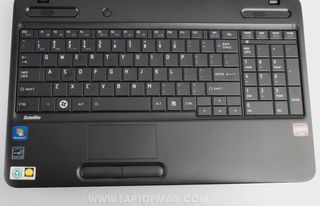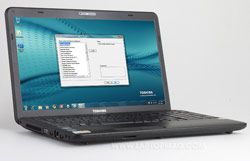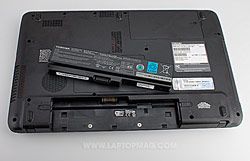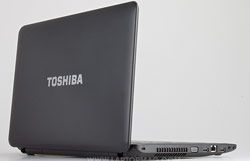Laptop Mag Verdict
This ultra-affordable, AMD-powered laptop pairs netbook-like performance with a larger screen.
Pros
- +
Very low price
- +
Nice textured finish
- +
Above-average battery life
Cons
- -
Netbook-like performance
- -
Shrunken spacebar
Why you can trust Laptop Mag
For the last few years, the sub-$400 notebook realm has mostly been the exclusive province of netbooks. Budget mainstream notebooks sometimes dip below the $500 mark, but it's usually a clearance item or a Black Friday deal. So the 15-inch Toshiba Satellite C655D may shock a few consumers when they see it with a $398 price tag at Walmart (where it's being sold exclusively). This machine offers a basic design, an AMD Fusion processor that promises slightly better performance than a netbook, and long battery life. Was Toshiba able to bring the mainstream budget price range down without sacrificing too much? Read on.
Design
Weighing in at 5 pounds, the Satellite C655D is pretty light for a 15-incher. The matte black lid and deck have a dimpled texture that gives the notebook a nice grip. Above the keyboard are two oval speaker grilles, which are also plastic, but have a nice glossy trim. We're fans of the simple all-black color scheme, which isn't marred by many ostentatious LEDs (though there are two that indicate when the Number and Caps Lock is on).
Heat
During testing, the Satellite C655D notebook remained pretty cool. After playing a Hulu clip at full screen for 15 minutes, the space between the G & H keys was only 83 degrees, the touchpad only 82 degrees, and the middle of the underside only 84 degrees. Those temps are all well within our acceptable range. The hottest area on the notebook was near the vent, naturally, but even then it only reached 95 degrees--also within the acceptable threshold.
Keyboard and Touchpad
The full-size keyboard and number pad on the Satellite C655D have responsive, terraced keys that offer good spring and return. However, we kept hitting the Alt keys by accident; for some reason, Toshiba made them, and the left Ctrl key large, at the expense of the spacebar, which is shorter than normal.

Click to enlarge
The 3.2 x 1.6-inch touchpad is nice and wide, and we like that the surface has just enough matte covering to reduce friction. While the Elan touchpad is capable of multitouch gestures, such as pinch-to-zoom, they weren't easy to execute. In addition, the scrolling area on the right wasn't very sensitive. Once we turned the two-finger scrolling on, the experience was better. The two discrete mouse buttons are wider than the touchpad and were responsive.
Display and Audio
We appreciated the crisp, popping colors and deep blacks offered by the Satellite C655D, as well as the wide horizontal viewing angles while watching Lady Gaga's Grammy performance. Vertical viewing angles are narrower than we'd like, and at times the reflections in the glossy panel were distracting.

Click to enlarge
At 75-percent volume, the two oval speaker wells above the keyboard produced enough volume to fill a medium-sized room. With the audio at 100 percent, we didn't notice much distortion. When listening to instrumental music, such as Zoe Keating's "Into The Trees," we didn't get the full, resonant tones of the cello. Adam Lambert's brash, pop/rock blend had all the treble but not as much of the bass. Plus, the tenor sounded on the tinny side. Still, for a budget system, the sound is fairly nice.
Ports and Webcam
For a system this size, the Satellite C655D offers a skimpy number of ports: two USB, Ethernet, VGA, a card reader, DVD+/-R, headphone and mic. It's not a surprise to find no HDMI port given the price, but we usually expect even budget systems to come through with three or four USB ports. There's also no Bluetooth included.

Click to enlarge

Click to enlarge
The webcam captured somewhat blocky and pixelated images, but the quality was not terrible. We were impressed that the Satellite C655D was able to handle low light situations, but even in the best light the colors were off.

Click to enlarge
Performance and Graphics

Click to enlargeThe Satellite C655D is powered by one of AMD's new Fusion APUs--a 1.5-GHz AMD E-240--which combines the CPU and GPU on one chip. On PCMark Vantage, a synthetic benchmark that measures overall performance, the C655D scored 1,325. Though this is well below the mainstream average of 5,013, most of the notebooks in this category have much more powerful processors. However, the $499 MSI CR650 and the $479 HP Pavilion dm1z--both of which have a 1.6-GHz AMD E-350 Fusion APU--scored 2,377 and 2,198, respectively. The Dell Inspiron 14R, a $499 system with a last-generation Intel Pentium CPU, scored 3,742.
Overall, the C655D's scores are more on a par with netbooks; its Geekbench score of 1,098 is about 100 points above the netbook average, and about even with the $399 Samsung NF310, which has a dual-core 1.5-GHz Intel Atom N550 processor.
In our real-world benchmarks, the C655D again lagged behind the competition. It took the system 9 minutes and 22 seconds to transcode a 5-minute, 114MB MPEG4 to AVI using Oxelon Media Encoder. The average mainstream notebook takes just 1:02. The MSI CR650 took 2:47, the Inspiron 14R 1:09, and the Pavilion dm1z 2:45. Even the Samsung NF310 dual-core netbook fared better on this test, completing it in 3 minutes and 50 seconds.
The 250GB, 5,400-rpm hard drive completed the LAPTOP File Transfer test (duplicating 5GB of multimedia files) in 3 minutes and 41 seconds, a rate of 23 MBps. This isn't too much slower than the category average (24.9), though the Inspiron 14R has it beat by 3 MBps (26). The C655D is faster than the MSI CR650 (19.8) and the Pavilion dm1z (18.4). However, the long 1-minute, 16-second boot time doesn't help the Satellite C655D's cause, especially when most mainstream notebooks boot in about 67 seconds.
In our hands-on time with the notebook, we were able to surf the web with multiple tabs open in Google Chrome while also writing this review in Open Office writer--without experiencing any sluggishness. However, when we fired up Windows Movie Maker on top of these apps and imported a video clip, the notebook slowed to a crawl. Just processing the video's thumbnails used up 80 percent of the CPU. We noticed something similar when we loaded the Firefox browser. With just five tabs open, it had already begun to take up 70 percent of the C665D's resources, slowing the system down. These are the kind of issues we expect with a netbook.
Graphics Performance and Video
On the graphics side, the Satellite C665D's integrated AMD Radeon HD 6310 GPU scored 1,997 on 3DMark06, a synthetic benchmark that measures graphics performance. It's no surprise that this is well below the mainstream average (3,740), but here the Toshiba fared better against comparable notebooks. It's below the MSI CR650 (2,225) and the HP Pavilion dm1z (2,217) but above the Dell Inspiron 14R (1,402) which has Intel integrated graphics. Of course, the Samsung NF310's weaker integrated graphics don't come close (147).
Real-world testing bears out these results. When playing resource-intensive Flash games on Facebook, the C655D often struggled to keep up, making for slow gameplay. In World of Warcraft, we measured frame rates of 22 fps with graphics set to Fair and the resolution at full screen.
On the plus side, high-definition video streamed from Vimeo and YouTube played smoothly, even at full screen and 1080p (from the latter site). HD clips played from the hard drive also ran smoothly. However, when we played an SD Hulu clip at full screen, we noted slight hitching.
Battery and Wireless

Click to enlargeOne area where the Satellite C655D did very well is on the LAPTOP Battery Test (continuous web surfing over Wi-Fi). It lasted 4 hours and 51 minutes, about 50 minutes longer than the average mainstream notebook. The MSI CR650's runtime was just a bit behind (4:38), and the Dell Inspiron 14R was almost 2 hours shorter (3:01).
The Realtek b/g/n wireless radio offered achieved a date rate of 29.1 Mbps at 15 feet from the router and only 15.6 Mbps at 50 feet away. Both scores are below the mainstream average (33.9/22.1) and well behind the MSI and Dell notebooks.
Software and Warranty

Click to enlargeThankfully, the C655D lacks the slew of useless trialware and crapware usually found on budget systems, and it includes a parcel of Toshiba's helpful branded utilities: Face Recognition, a 30-day trial subscription of Online Backup service, Service Station, Recovery Disk Creator, and HDD/SSD Alert should keep your data safe. There's also a 30-day trial of Norton Internet Security 2011.
The new Toshiba Bulletin Board (for aggregating calendars, photos, and other info) and ReelTime (for accessing recently opened files and programs) are also on board, as is Toshiba App Place for guiding less tech-savvy users toward programs they might find useful.
One notable piece of pre-loaded software is the Google Chrome Browser, which has a clean interface and is plenty fast.
Configurations
Even if you're not a Walmart shopper, you can still snag this laptop for a low price. There are 32 models in the Satellite C650 Series, with prices starting at $398 and going up to $679. (The C650 is currently available for $378, though we don't know how long that special will last.) Within this series, there are multiple CPUs available from both AMD and Intel, including nine in the AMD E-Series, three in the V Series, and seven with AMD Athlon II Dual-Core Mobile chips.
On the Intel side, customers have their choice of Celeron, Pentium, or Core i3 processors. None of the models have discrete graphics. There are a few systems with as little as 1 to 2GB of RAM, but we suggest going for a model with 3 or 4GB of RAM. Hard drive sizes range from 250GB to 500GB. There are no color options in the C655 series--just basic black. Toshiba also offers customers the option to customize a system exactly to their liking, with the base model starting at $349.
Toshiba covers this notebook with a one-year warranty on parts and labor and a one-year warranty on the battery. To see how Toshiba did in our Tech Support Showdown, click here.
Verdict

Click to enlarge
It helps to think of the Toshiba Satellite C655D more as a big netbook than a well-rounded mainstream notebook. At $398 (currently $378 at Walmart), it costs the same as many of those higher-end 10-inch systems, yet it offers a much larger screen and better graphics. Still, consumers must temper their expectations. Even though it has a 15-inch screen, you can't expect it to perform like similarly sized notebooks that cost $150 more. But if you're looking for a very basic laptop and a 10-inch screen is too small for you, the C655D is a pretty good deal.
Toshiba Satellite C655D Specs
| Brand | Toshiba |
| CPU | 1.5-GHz AMD E-240 |
| Card Slots | 4-1 card reader |
| Company Website | http://us.toshiba.com |
| Display Size | 15.6 |
| Graphics Card | AMD Radeon HD 6310 |
| Hard Drive Size | 250GB |
| Hard Drive Speed | 5,400rpm |
| Hard Drive Type | SATA Hard Drive |
| Native Resolution | 1366x768 |
| Operating System | MS Windows 7 Home Premium (64-bit) |
| Optical Drive | DVD+/-RW DL |
| Optical Drive Speed | 8X |
| Ports (excluding USB) | Microphone, Kensington Lock, Headphone, Ethernet, VGA |
| RAM | 3GB |
| RAM Upgradable to | 8GB |
| Size | 15.0 x 9.8 x 1.5 inches |
| Touchpad Size | 3.2 x 1.6 inches |
| USB Ports | 2 |
| Video Memory | Shared |
| Warranty/Support | 1-Yr Parts and Labor, 1-Year Battery |
| Weight | 5.0 pounds |
| Wi-Fi | 802.11b/g/n |
| Wi-Fi Model | Realtek RTL8188CE |
